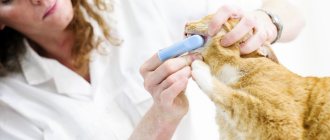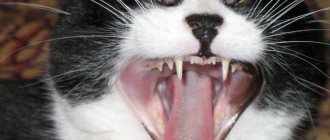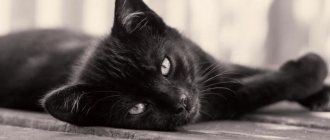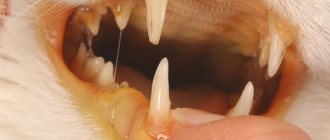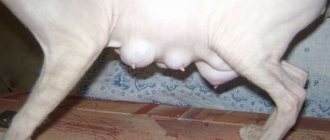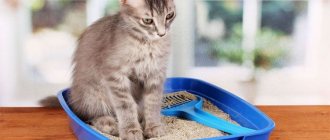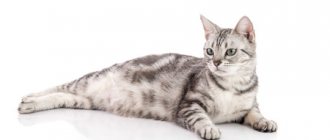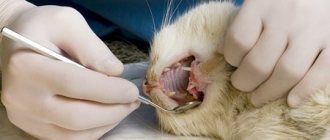In dental practice, an operation such as removing teeth from a cat under anesthesia is often performed. Owners of furry pets are faced with the need to carry out such a procedure on young animals and adults. A dentist at a veterinary clinic can help with solving dental problems, the development of inflammatory processes and various diseases in the mouth. Unfortunately, a large number of furry patients are brought to see a doctor only when the situation has reached a critical state and they can no longer be saved.
When do kittens lose their baby teeth?
Kittens are born toothless. At 7–14 days of age, their primary incisors appear. By 2 months, babies should normally have 26 teeth. As they grow older, they fall out and permanent units grow in their place. Hair loss begins at 3–4 months of age. The process of changing teeth takes approximately 3–4 months, being completely completed by 7–8 months.
The first to erupt are the permanent incisors - the anterior units responsible for biting food. Then fangs appear, which perform the function of holding and tearing food. The last to be cut are the molars and premolars. Chewing teeth have the thickest walls and the widest bases to serve their owner for at least the next 7–8 years.
Formation of dental occlusion from the birth of a cat
A complete set of baby teeth in cats consists of 26 pieces. The onset of gum eruption occurs between 2-3 weeks from birth (usually closer to 3 weeks). A complete primary dentition is formed by 6 weeks (maximum by 8). The appearance of the first sharp teeth is a signal that the kittens can begin to be introduced to “chewable” complementary foods.
Teething order:
Healthy baby teeth in a kitten
- incisors (2-4 weeks from birth);
- fangs (3-4 weeks);
- premolars (6-8 weeks).
Cats' milk teeth are whiter and thinner than their permanent teeth.
Pathological causes
Owners should be alert to the loss of teeth at the age of an animal from 1 year, when permanent teeth fall out. It is important to understand that a cat’s teeth do not simply fall out, with the exception of milk teeth. Most likely, the pet has serious health problems, not only in the oral cavity, but also in the internal organs.
Signs of pathology are:
- hyperemia and swelling of the gums;
- bleeding lines near the gums;
- ulcers on the lips and gums;
- ulcers, pus in saliva;
- hypersalivation.
When observing a cat, you will notice that it is irritable, sometimes aggressive, and refuses food, even if it is hungry. When trying to eat, your pet does it very slowly and tries to chew only on one side. He also drinks reluctantly. You can tell that an animal has a problem by its strong smell - its breath stinks very strongly.
The causes of tooth loss include:
- Disturbance of the microflora of the oral cavity (dysbacteriosis).
- Injuries.
- Weakening of the immune system.
- Vitamin deficiency, which can be caused by a lack of B vitamins, iodine, fluorine and phosphorus in the feed used.
- Long-term treatment with hormones and antibacterial drugs.
- Tartar, which is a dark plaque on the enamel that must be removed.
- Diseases of the teeth and gums (periodontitis, gingivitis, stomatitis, caries, pulpitis).
- Infections, viruses.
- Malocclusion.
- Gastrointestinal diseases.
- Oncology.
In case of injury, as a rule, fangs and front incisors fall out; in case of internal diseases, absolutely any tooth can fall out. Molars and premolars fall out extremely rarely.
Preparation for the operation
Before such a procedure, the doctor checks the animal’s blood pressure.
Initially, you must consult a veterinarian who will measure your pulse, blood pressure and body temperature. Palpation and percussion of the pet and a full examination of the oral cavity are also carried out. Ultrasound examination is considered an important procedure for identifying hidden forms of pathology of internal organs. It is recommended to submit urine and blood for clinical analysis and biochemistry.
The veterinarian will recommend that the animal owner consult a cardiologist to identify problems with the cardiovascular system in order to avoid negative consequences from anesthesia.
At what age do cats normally lose their molars and in what order?
In adulthood, these animals should not lose teeth. Normally, they fall out once during their life - when changing temporary units to permanent ones. Some people mistakenly think that tooth loss in older animals is normal. However, even in old age this should not be the case. In all cases, tooth loss in cats is a consequence of some internal or external problem.
Consequences
Your pet may remain lethargic for some time after the procedure.
After surgery to remove teeth, a cat may feel worse and may experience nausea and vomiting. Weakness, lethargy, apathy, and lack of appetite appear. Swelling of the gums for 1-2 days is considered normal; for this reason, the dentist prescribes antibiotics in the form of intramuscular injections. If you ignore this and start the condition, an abscess may occur - a total inflammatory disease of the oral cavity.
Tartar removal
Tartar causes pain and tooth loss. Fangs are most often affected. Owners of four-legged pets should know what to do when a cat's fang falls out and how to prevent the loss of other teeth.
The stone is removed independently:
- Can be treated with hydrogen peroxide. Moisten the gauze and clean the problem area. Rinse your mouth with a decoction of herbs.
- They are given toothpick toys to chew on.
- Use a silicone brush - put it on your finger and clean the sore spot.
- Polish the stone with a cloth soaked in a special solution.
Note! When they can’t cope, they go to the vet. The doctor removes the stone manually or with ultrasound.
Oral hygiene - prevention of dental diseases
How to feed an animal whose teeth have fallen out or been removed (all or several)?
The diet of an animal that for some reason has lost one or all teeth should consist exclusively of soft food. It can be fed wet ready-made or pre-soaked dry food. Do not use broth or milk to soften the granules. It can only be soaked in water whose temperature does not exceed 30°C. Under the influence of hot liquid, the proteins contained in dry food are denatured, ascorbic and folic acid, thiamine, carotene and riboflavin are destroyed, and vitamins A, D and E are oxidized.
Cat food should be at room temperature. Too hot or cold food is contraindicated for animals with sensitive gums.
Ways to solve dental problems
How to brush a cat's teeth: options at home
Pets can have caries and gingivitis, as well as osteomyelitis and periodontitis. At first they all look like caries: the enamel is destroyed. Therefore, only a good veterinarian can accurately diagnose the problem.
Regular caries goes through several stages before a cat's gums become inflamed. Pain appears precisely from this, already in the later stages.
A sign of caries is a white spot on a canine or premolar. At this point, the owner can still help the cat. The stain is treated with hydrogen peroxide, and the mouth is washed with herbal infusions.
When they can’t help, they go to the vet. The dentist has special cauterizing agents in his arsenal. If they do not help, or the disease is advanced, the diseased element is removed. The operation is performed under full anesthesia, and the wound is sutured.
For several days after this, the animal is given painkillers.
Problems are solved using other, less drastic, methods:
- Organize proper nutrition. You need to feed your cat moderately soft food, but with layered solid inclusions. This provides the necessary load on the gums.
- They use drugs to strengthen teeth: antibiotics, antiseptics. When infections are eliminated, inflammation does not occur in the oral cavity, which leads to dental diseases.
- Strengthen the gums with ointments Metrogyl Denta, Dentavidin. The drug Zubastik helps a lot.
- They give vitamins and immune support products. Which ones are determined by the veterinarian after examining the animal. A weak immune system and lack of vitamins and minerals in the diet lead to weakened gums. They bleed and become breeding grounds for bacteria and germs.
- Strengthen teeth with nutrition: Denta-Kiss Gimpet (2-4 tablets daily), Beafar crispy pads (5-6 pieces per day), Happy cat cookies.
Technique: main points
After thorough preparatory procedures for all teeth, the animal’s oral cavity is washed with an antiseptic. The yawner is then inserted and the tongue is removed manually. The gums and mouth are lubricated with iodine, then an incision is made with a medical scalpel, after which the diseased tooth is sharply loosened in different directions with forceps and pulled out. Canines and molars are the most difficult to remove. Bleeding often occurs during surgery but stops using conventional methods. To do their work, dentists use articulated forceps, they grab the tooth root, shake it with smooth movements and, when the hinge rests on a healthy tooth nearby, press the handle of the instrument towards the opposite jaw. After this, the affected incisor is easily removed from the oral cavity.
There are cases when the extreme molar does not lend itself to such a procedure and must be knocked out. This is the most difficult dental surgery for cats. To carry it out, trepanation of the jaw of the upper sinus is performed. A round chisel is inserted through the resulting hole and, with short, gentle blows of a special hammer, the diseased tooth is knocked out from the alveolus, only after which is it possible to remove it with forceps. After the procedure, the oral cavity is treated with a solution of potassium permanganate and water, always maintaining a ratio of 1:500, for which sterile swabs and clamps are used.
The veterinarian offers high-quality dental extraction services for cats and also provides assistance to owners with pet oral care.
Preventing tooth loss in cats
In order for your four-legged pet to retain all its teeth until the end of its life, the following rules must be followed:
- regularly remove plaque and tartar;
- feed your four-legged pet correctly;
- when feeding your pet natural food, periodically give it vitamin and mineral complexes, having previously agreed with your veterinarian;
- Conduct preventive veterinary examinations at least once a year;
- promptly treat diseases identified in the cat;
- When feeding an animal with ready-made food, agree on the chosen brand with your veterinarian;
- protect your four-legged pet from falling from a height, collision with vehicles, fights with relatives;
- Correct your cat's malocclusion in a timely manner.
Share with friends!
Diagnosis and treatment
To prescribe adequate therapy, the doctor must conduct a diagnosis, which includes collecting information that will help him determine why the cat has bad breath and teeth falling out, a visual examination of the animal, and laboratory tests.
The main treatment measures include:
- Adjusting your diet.
- Elimination of the underlying disease.
- Removal of tartar (if any).
- Fortification, strengthening the immune system.
- Taking medications that strengthen teeth and reduce bleeding gums.
Indications: when is it required?
This procedure is performed for chronic diseases of the oral cavity. Removing teeth from a cat makes it possible to avoid complications of the disease. The main indications for the operation are:
- periodontitis;
- crowded teeth;
- broken fangs;
- deformation of the entire dentition;
- odontoclastic lesions of the oral cavity;
- root resorption;
- tartar;
- milk teeth that did not fall out on time;
- stomatitis.
Return to contents
How can you tell if your teeth have changed?
The appearance of permanent teeth differs from temporary teeth. Milk ones, as a rule, are very sharp, akin to a well-sharpened dagger; the fangs have a curved shape and thinning in the gum area. While the permanent canines are straight and more rounded at the ends, and the neck is without thinning.
By the way, when changing teeth, you should not be afraid of the so-called polyteeth, when a kitten suddenly has 8 fangs instead of 4. The fact is that the molars are not formed in the same alveolus as the temporary ones, but nearby. So it turns out that one fang has not yet fallen out, but a new one has already grown.
In rare cases, a growing tooth pinches the root of the milk tooth, then the kitten begins to feel discomfort: it does not eat, periodically squeals pitifully and generally feels unwell. The problem is not global and is easily solved by removing the extra tooth.
You should not try to remove it yourself; it is better to take your baby to the veterinarian. It is possible that local or general anesthesia will be required. At the same time, the doctor will check for what reason the pathology occurred (perhaps the kitten has an incorrect bite or a developmental anomaly).
In what cases does a veterinarian recommend tooth extraction?
Let's look at the cases in which teeth are removed.
- Incorrect placement of milk or molars, which interferes with the normal functioning of the animal - the soft tissues of the oral cavity are damaged.
- In severe cases, where conventional treatment has not yielded results - feline lymphoplasmacytic stomatitis.
- Teeth that are close to each other is called crowding. In this case, there is a risk of getting sick because Food will accumulate between the teeth and this will lead to an inflammatory process.
- Internal root resorption
- External root resorption
- Milk teeth that did not fall out on time on their own, but the molars have already begun to grow and the milk teeth interfere with the growth of new teeth.
- Teeth located under the gum mucosa are also subject to removal. They have not erupted, but a cyst may form under the gum and this will harm the adjacent teeth.
- The indication for tooth extraction is periodontal disease.
- Odontoclastic resorptive lesion of teeth – classes 2,3,4
Tooth extraction is carried out only under anesthesia. After tooth extraction, your pet must have the wound sutured, otherwise there is a risk of infection, and the wound will take a long time to heal.
Preventive measures
It is recommended to visit the veterinarian once every six months so that he can examine the animal’s oral cavity for the formation of tartar. If it is not possible to visit a veterinary clinic, you need to regularly examine your pet yourself.
Timely cleaning of teeth from plaque (about once every 5 days) can significantly reduce the risk of tartar formation. It is recommended to introduce the animal to this procedure from a very early age so that its indignation does not interfere with cleaning.
Regular dental examination and brushing are the most effective means of preventing dental plaque.
The food your cat eats should contain tough ingredients and grass. There are foods on sale that contain special granules that clean the surface of the teeth mechanically and contain polyphosphates; they settle on the teeth and prevent the formation of plaque. Taking multivitamins helps maintain dental health. And by allowing your cat to chew on cartilage, chicken necks, or letting you play with a toy, you will reduce the likelihood of plaque on your teeth to a minimum.
The influence of old age
In a healthy pet, age has no effect on the condition of the teeth. If your cat has lost a tooth, it is definitely not due to old age, but due to health problems, improper maintenance, feeding and care. Unless your cat is twenty years old or older. Cats very rarely live to this age and anything can happen to their body, because the very fact that a cat lived to be twenty years old is a miracle!
As they age, their teeth wear down. The lower incisors are the first to change shape, and then the surface of the back teeth is smoothed. The last to undergo changes are the fangs.
Anesthesia before surgery
Anesthesia is considered a prerequisite for the procedure. The painkiller is injected into a vein in the animal, usually in the back leg. Before giving such an injection, the pet's fur in this area is shaved clean. If necessary, during the operation the doctor may prescribe emergency additional anesthesia with a special gas, for which a cone-shaped mask is used. It is important not to overdo it with anesthesia, especially for older cats and those with heart problems. For successful tooth extraction surgery, it is recommended to keep the cat without food for up to 10 hours. Otherwise, due to the administration of painkillers, nausea and vomiting may occur.
What to ask from a doctor
For animals, as for people, going to the doctor is not the most pleasant event, and for some it is even stressful. If possible, such pets are left at home and a veterinarian is called to the house.
In your case, you will have to coax the cat a little and take him yourself, because he cannot collect all the tests the doctor needs at home.
Veterinarians generally love animals and want to help them, but not everyone loves their job. If you know your doctor well and have been taking your pet to him for many years, then you have nothing to worry about. If the doctor is new to you, make sure that he does everything necessary to make a correct diagnosis.
The veterinarian must:
- Ask in detail about your cat’s lifestyle, its diet and general condition.
- Carefully examine the oral cavity with special instruments.
- Take the necessary tests.
Rehabilitation
The first day after surgery is considered the most critical in recovery. At this time, it is recommended to carefully monitor the pet’s condition and not leave it unattended. The first thing you need to do when you get home is to put the cat on the floor in a secluded place where there are no drafts or heaters. You cannot put an animal on the bed, as it may fall and get injured. Proper rehabilitation allows you to feed the cat only after complete recovery from anesthesia. You need to start with a light semi-liquid warm meal.
As soon as the animal wakes up, water is given from a pipette to moisten the mucous membrane, and so on every half hour. It is important to ensure that the pet does not start drinking from the owner’s cup or his own bowl on his own, as he may choke while signs of anesthesia are still present. It is necessary to place the cat's litter box next to the place where he rests. Every hour it is recommended to measure body temperature, measure heart rate, and examine the mucous membranes of the eyelids and oral cavity. After tooth extraction, it may be necessary to administer special injections and treat sutures in the mouth.
Precautions
From three to six months, the kitten should receive all the nutrients it needs. If the kitten eats the same thing as you, you need to give it additional vitamins and supplements.
It is better to choose professional dry food for kittens. The kitten must be able to chew something, otherwise he will begin to taste furniture and other things, and this is not good for either him or you.
Ko6e4ka.ru advises buying special chew treats and food with large granules.
During the period of teeth change, the kitten's immunity is very weak, so vaccines cannot be given. You should also avoid contact with other animals.
If the gums are severely inflamed and the molars begin to grow incorrectly, contact your veterinarian.
What treatment is prescribed?
If diagnostics show that the primary source of dental disorders is internal pathologies, then therapy aimed at eliminating them is first prescribed. If a kitten's fang falls out during a tooth change under one year old, no treatment is prescribed. During this period, it is important to monitor the condition of the oral cavity and feed the baby high-quality and balanced food.
If the symptom is associated with some external traumatic factors, then antibiotics may be included in the therapy.
When a cat's teeth are knocked out or mechanically damaged and sticking out, the doctor will remove the remains and prescribe a drug therapy regimen, including antibiotics and painkillers. If an elderly cat loses a long fang, this is also not considered a pathology. To maintain the body, the doctor will recommend taking courses of vitamins, as well as switching to soft and crushed foods.
Why does a young cat lose teeth?
If a young pet’s teeth fall out, it doesn’t matter whether it’s a canine, a molar or an incisor, you need to find out the cause of this phenomenon as quickly as possible. Usually their loss is the result of some pathological process in the cat’s body or exposure to external factors. Tooth loss cannot be stopped without eliminating its cause. In some cases, the future fate of the four-legged pet depends on the timeliness of the measures taken.
Diseases of teeth and gums
If an adult, but not yet old, pet has lost a tooth, it may be due to a dental disease. This problem can be caused by:
Deficiency of vitamins and minerals
The lack of necessary substances primarily affects the appearance of the four-legged pet. Over time, it affects the functioning of internal organs and the condition of teeth. Without receiving full nutrition in the form of vitamins and minerals, the gums cease to perform their main function, as a result of which the teeth begin to loosen and fall out. This process can begin with one or more units.
Age-related changes in the dental system of cats
The age of cats can be easily determined by their teeth, or more precisely by the degree of their wear. The central and lateral incisors of the lower jaw are the first to wear off; with age, the surface of all incisors takes on a transverse oval shape. The more teeth a cat has, the older it is. The very last to be involved in the process of enamel abrasion are the fangs.
Senile tooth loss, especially the canines, is quite rare in cats and occurs mostly due to improper care. Although it is quite natural that if an animal reaches twenty years of age, it is unlikely that it will have the number of teeth given by nature in its mouth. Most likely, you will definitely miss a couple or three pieces.
KotoDigest Thank you for subscribing, check your inbox: you should receive an email asking you to confirm your subscription
Symptoms of tooth change
The owner can learn about the beginning of the process by the following signs:
- The animal has increased salivation.
- Upon visual examination, bleeding from the gums is observed.
- By touching the teeth with your finger, you can understand that they are quite wobbly.
- Complete or partial refusal of your favorite food.
- The kitten tests all the objects around.
If you observe these symptoms, then do not worry, they are temporary. No treatment is required. And there is no need to run to the veterinarian, because you know why a young cat’s teeth are falling out at this stage.
Of course, sometimes there are failures in changing teeth. For example, a small kitten does not develop four fangs, as expected, but 2 or 4 more. Don’t worry, it only seems at first glance that there are a lot of teeth. In fact, the molar grows in the same follicle as the baby tooth. The radical one displaces the milky one, displacing it.
- Presence of a dark red stripe along the gums
- Gums are red and swollen
- Chewing food is difficult
- Increased salivation
At the first manifestation of such symptoms, you need to think about how to treat your cat’s teeth. It is highly advisable to make a decision about dental treatment for your pet in a specialist’s office.
Changing baby teeth to permanent ones
When do kittens/cats change their baby teeth?
Changing teeth in cats is a painless process and usually goes unnoticed by the owners. The onset is noted at 3-5 months of age. By 7-8 months, a permanent molar bite is usually formed, including 30 teeth.
The permanent dentition consists of:
- 12 incisors (6 on each jaw);
Diagram of permanent teeth
The added 4 molars are missing in the primary dentition.
The order of changing teeth
There is no clear order and exact timing for changing teeth, but most experts are of the opinion that in cats everything changes in the same order as it grows:
- first the incisors (at 4-5 months);
- then fangs (at 4-6 months);
- The last ones to be replaced are the premolars (at 5-6 months);
- molars grow (by the end of 6 months).
Characteristics of a healthy grin
A healthy grin on a cat's face
Healthy molars start out pure white, but over time acquire a slight tint of yellow. After 4-5 years, you can observe signs of abrasion of the tooth surface due to age - the fangs become slightly dull, and the curvature of the premolars and molars is smoothed out. Cats older than 5-6 years of age may already be missing some permanent teeth, but healthy animals cope well without them.
How often do cats' teeth change?
The dentition of domestic whiskered predators changes once in a lifetime, replacing milk components with permanent ones. If tooth loss has been noted at any age over 1 year, then this is not normal and there must be a specific reason for it.
Caring for a kitten during the period of teeth change
If we talk about a person, then this disease shows the presence of inflammation of the tooth root. In cats, this will mean inflammation of the ligaments that hold the tooth in the jaw. If the ligament is torn, the tooth will fall out. You can notice that your pet has periodontitis by several symptoms: an unpleasant odor from the mouth, unhealthy red gums, increased salivation. In addition, the animal will refuse food and lose weight very quickly.
Many veterinarians advise regularly giving kittens vitamin complexes, but this should only be done if there is direct evidence from a doctor, since an excess of certain groups of vitamins can also adversely affect the health of the pet.
Teeth indicate a cat's age
The correct structure and the absence of any pathological signs generally indicate the health of the oral cavity. In addition, by looking into the animal's mouth, you can find out the cat's age by its teeth. Determining how old or young a pet is is quite simple, being aware of some nuances:
- The furry baby is apparently not even a month old, if his incisors have just begun to erupt.
- In an older kitten, the beginning of the process of losing baby teeth indicates that he is approximately 3-4 months old.
- If a kitten already has a full set of 30 teeth, it is probably at least six months old.
- An adult one-year-old animal has a snow-white grin and practically no plaque.
- By the age of two, the lower central incisors of cats begin to wear off, the enamel noticeably turns yellow, and the first tartar appears.
- At five years old, pets already have fairly worn out upper incisors and mandibular canines.
- After another couple of years, pigmentation occurs on the surface of the enamel.
- By the age of 10, cats' incisors often fall out.
- In older animals - 15 years and older - even their fangs fall out.
The structure of the teeth does not always allow one to accurately determine how old a cat is. Sometimes improper oral care of an animal or lack of it at all leads to the fact that the pet’s dental system begins to age prematurely. Periodic brushing of teeth and a balanced diet will help your cat maintain a satisfactory level of oral health and prevent the development of diseases.
When do kittens' teeth change? Small mustaches sometimes reach their new owners very early. And you need to know a lot about their development, body characteristics and care in order to raise a beautiful and healthy animal. Including, of course, you need to be aware of such an issue as the change of baby teeth in kittens - at what age this happens and with what symptoms. We will talk about this today.
Cat teeth are a formidable weapon of the ancestral wild cat and a “tool” for high-quality nutrition of the modern domestic cat. Owners who care about their pet (or pet, if we are talking about a cat) should monitor their condition from the moment the pussy appears in the house. And not just observe, but take care, as dentists say, “of the oral cavity”!
An adult healthy cat has three dozen permanent teeth in its mouth (kittens have 4 fewer - 26 in total) - 12 incisors on the upper and lower jaws, 4 canines, 3 molars at the top and 4 at the bottom. And all of them should be white or cream, strong, without signs of inflammation or destruction. And the gums are pink. Much here depends on the quality of the animal’s nutrition, but it is also important on when and how the kitten’s teeth were changed and what kind of care the owners provided him during that period.
When do cats' teeth change?
Owners who have recently adopted a small cat into their home constantly ask veterinarians and specialized online forums: when do kittens’ teeth change? Meanwhile, the owners will be the first to know that the pet’s incisors, canines, premolars and molars have begun to change. And to do this, you don’t even have to look into the animal’s mouth.
A kitten whose teeth change dramatically changes its own behavior. He becomes restless, meows often and loudly, informing his owners of discomfort. And the little cat begins to chew everything. Slippers - so slippers, wires - so wires, the owner's hands - that means arms, or even legs! Anything your heart desires can end up in a cat's itchy mouth. Rags, toys, books (especially those that are thicker, with “appetizing” voluminous spines), pencils and computer mice... It’s an eye-catcher!
In general, during the period when kittens’ teeth are changing, owners are required to pay close attention and control over the pet’s behavior. And also competent thoughtful care. Starting with nutrition and ending with careful hygiene of the cat’s mouth. This is necessary so that the cat’s permanent teeth grow strong and correctly, and the gums and mucous membranes remain free of inflammatory processes.
Kittens are born completely toothless; teeth begin to appear only at two weeks of age. During this period, kittens - just like little children - are very restless and try to scratch their gums on anything - from their own paws and the fluffy tails of their littermates to the edges of a basket or bed.
At the age of 3-4 or even 5 months (much depends on the breed and on the individual development of a particular individual), cats’ teeth begin to change. This happens gradually, one might say in stages - first the incisors change, followed by the canines, and then the turn comes to the premolars and molars. And by seven months, the “dental exchange” ends in almost all domestic felines.
Of course, anyone who gets a cat must know everything about the change of teeth in kittens - when and how this happens, in order to provide special nutrition for their mustache during this period. In general, during this difficult period the animal requires special care and maximum attention from the owner.
Do kittens lose their baby teeth?
Yes, kittens are just like little guys. And tiny sharp teeth change in the same way - milk teeth fall out, permanent teeth grow. Therefore, the question that is relevant for many owners: do kittens lose their baby teeth can be answered with confidence in the affirmative. Moreover, if for some reason not all of a cat’s non-permanent teeth have fallen out, then they will have to be removed by a veterinarian.
Why delete? Yes, because excess teeth in the animal’s oral cavity can lead to injury to soft gums, the formation of wounds and ulcers on the mucous membrane. In addition, more serious problems with the bite and even with the bone tissue of the cat's jaw may arise. And such a “trifle” as periodontal disease is definitely guaranteed for your pet.
Prevention measures
If you pay attention to your cat’s health and provide quality care for it, then problems such as tooth loss can be avoided. Regular brushing of teeth is the prevention of tartar, which, most often, is a provoking factor. Cats living outside clean their mouths on their own by chewing twigs and grass.
Pets are deprived of this opportunity, so the owner must regularly carry out hygiene procedures - brushing their teeth. If you accustom a cat to them from an early age, he will not resist the process, perceiving manipulation as a natural process.
To clean teeth, special pastes are used, which can be purchased at a veterinary pharmacy. Such pastes do not need to be washed off with water.
Human pastes cannot be used, as a high concentration of some components in the composition will negatively affect the health of the pet. In addition, the smell of menthol contained in most toothpastes irritates animals.
You can brush your teeth with a special brush, but a regular brush for small children with soft bristles will also work. To prevent tartar, use toys and medicated dry food, which should be given from time to time.
Particular attention should be paid to feeding the pet. If preference is given to natural food, the diet includes meat, fish, vegetables, and dairy products. Food from your own table is prohibited. If you use dry food, it is advisable to choose premium and super premium products that contain sufficient amounts of vitamins and minerals.
It is imperative to take your pet to a veterinary clinic so that diseases can be identified at an early stage, vaccinated in a timely manner, and treated for parasites. To avoid injury to the jaws and head area, you should not leave your four-legged pet alone. Windows and vents must be closed in your absence!
